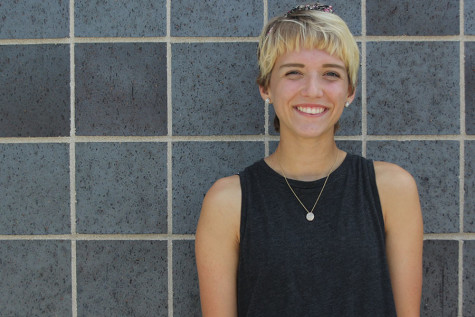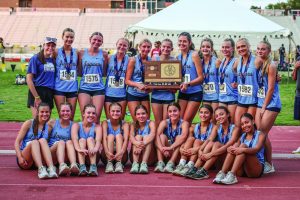Teachers: Should they be armed?
While arming teachers can help stop a school shooter in the act, it still does not eliminate the student’s ability to bring a firearm to school
October 9, 2015
Since the 1999 Columbine shooting, there have been 262 school shootings total. Like clockwork when these tragedies happen, President Obama and liberals shout “control the guns” while conservatives strike back with “2nd amendment.” And, in that cycle, there are those who say “arm the teachers.”
The idea behind arming teachers is to have an immediate response to when an incident begins, instead of waiting on law enforcement to arrive. In most cases by the time help arrives, the damage is already done and the shooter has maybe taken their own life too. In 2014, to respond to the Sandy Hook shooting, some Missouri school districts began training teachers to conceal and carry while teaching. Only district administrators, other teachers in the program and local law enforcement officials will know who is carrying. Also, students are now prohibited from hugging their teachers in case they detect a firearm.
While this is smart, if prohibiting close physical contact is not enforced, the detection and awareness of a teacher’s firearm could put him or her at risk to being a target by a student who desperately wants that firearm. Also, the teachers are given a special kind of bullet that can only hit one target and prohibit it from passing through the intended target and wounding another student. While I am so thankful that school districts that have followed through with this program have taken in all of these possibilities and made it relatively safe, arming teachers also costs over $17,000 per school district. Many schools in America, especially in lower-income areas, just don’t have the funds to commit to that.
An extreme version of the arming teachers argument is that every single teacher should be armed. Steve Siebold wrote, “It’s the way it has to be and if teachers aren’t comfortable with [being armed] they’re going to have to find a new profession.” I am 5 feet 7 inches and about 117 pounds, and struggled with keeping my body from moving in response to the kick of my father’s rifle when he took me shooting eight weeks ago. Do you really expect my 5-foot-4-inch teacher who I mistake as a student to handle a firearm and perfectly respond to a school shooter scenario? I don’t think our teachers who are not appropriately paid are paying off student loan debt because they wanted to also be required to conceal and carry while they teach us how to write Jane Schaffer essays.
Also, if every teacher in the school were required to carry a firearm, that would mean 94 guns would be in the building and students would know where to get their hands on one. If we resort to arming teachers, I vote for what the Missouri school districts are doing, which is only arming a couple teachers, giving their staff members the choice to be armed and not disclosing who is.
But, even with some armed teachers out of dozens, arming a teacher does not eliminate the possibility of a student bringing a legal pistol, rifle or even military-grade weapon (which someone can currently buy from Cabelas) into school. It also does not eliminate the fact that student shooters most likely do not fear dying themselves, because they want to be martyrs or have become aware of their actions and feel guilty. An FBI study shows that in school shootings from 2000-13, 40 percent of the 160 incidents had shooters take their own lives.
While I agree with the argument of the teacher being able to stop the student before he or she hurts anyone or any more people, the fact of the matter is, it is still possible for the student to bring a weapon into school.
If we spend money on arming teachers, we should also spend money on educating students about how to respond to school shooter scenarios. Yes, we have all learned that we need to run as fast and as far as we can go. Most, however, don’t know that although shooters might bring dozens of rounds and clips of ammo with them, they are still going to have to reload. So, students have a 10-30 second window, depending on how good the shooter is at reloading, to do something to stop them.
In the Umpqua college shooting, the shooter was changing his clip while he bought time and told students to stand up and if they believed in God. There was not a better time than that to overtake him then, when his weapon was not able to fire (speaking from a standpoint of not knowing he had three other guns on him). Yet, when faced with a man flailing around a gun, I might be rooted to my spot too. Thankfully, my classmates or I have never had to make that decision.
Please encourage your peers, teachers, families and government officials to not just end this discussion with “those families are in my prayers” once again. We as a nation need to have a healthy and civil discussion on safe gun practices and ownership, which firearms are deemed appropriate to own and what we can do to protect our schools in the most affordable and effective way possible. Lets work together on this.











Tom McClain • Oct 11, 2015 at 2:34 pm
Dylan, Shelby-
Props to both of you on changing my mind on the question of arming teachers. Still, I do not think that having an armed population will ensure the safety of our country, an opinion that is supported by research demonstrating the link between weak gun laws and increased violence (http://m.livescience.com/27740-gun-laws-deaths-study.html). I also think that a scenario of mutually assured destruction between teachers and a potential shooter is hardly a comforting one. We cannot assume that a firearm deterrent is a permanent solution for school shooters, particularly that 40% Shelby referenced who are bent on martyrdom. My fear is that we will assume the arming of teachers will solve the problem, rather than treating it as a temporary solution to be used in conjunction with stricter regulations on the type of firearms available, how they are sold, and who gets them ( http://smartgunlaws.org/background-check-procedures-policy-summary/ ).
But I digress. I think the opt-in program for teachers to arm themselves is a solid idea, and though I trust Dylan’s math, I doubt that the district will be able to easily cut $17,500 from the budget, no matter what percentage of the total it represents. What we need here is a state, or even federal, grant program to provide funding for districts who agree to the training, no matter what income class they represent.
Finally, an issue I thought both of you should have touched more on. As is the case with many school shootings, including the one at Umpqua Community College, the shooter is 1) a student at the affected school and 2) suffering from a mental illness. There is an opportunity here. I cannot offer a detailed solution, but if we are asking our school staff to shoot someone we should also train them to identify possible warning signs for an attack, and have the administration and school psychologist aware of the student’s disease and condition. It is all to easy to focus on the symptoms rather than the causes of these tragedies and fail to recognize the preventability of at least some of them. For more on the relationship between mental health and gun violence, I highly recommend John Oliver’s excellent piece on it: http://youtu.be/NGY6DqB1HX8
Thanks again to the both of you for an informed discussion on this crucial issue. I’d be happy to answer any future questions/comments.
Dylan Smith • Oct 11, 2015 at 4:44 pm
Tom,
I am in full agreement that we need to look into a solution for all 100% of potential school shooters. However, right now we are stopping 0% of shooters from entering school buildings with guns so if we can stop 60% by arming teachers, while it may be a temporary solution, it I’d 60% more than we were stopping before. Also, while the other 40% may still attempt to enter the building with a gun, it is safe to assume that they would be stopped much more quickly than ever before saving even more student lives.
Concerning the Shield Solutions program, the reason I assume the district could find $17,500 very easily is because of the recent recall election of Scott Hancock. In a Mill Valley News article written a few months ago by Justin Curto, it is stated that “the estimated cost for the recall election is $10,000-$20,000.” (https://www.mvnews.org/district-votes-to-recall-board-of-education-member-scott-hancock-in-election/) If the district is willing to pay that amount of money to kick a man off of the board of education then the district should be willing to pay a similar amount to save the lives of students.
I believe that education teachers on warning signs of mental illness is a fantastic idea. I think that this alone could stop even more shooters than you think. I do not believe any sane student would ever enter a building full of his peers with intent to kill, meaning that any student who is willing to take on the role of a school shooter has an identifiable mental illness. Students should also be educated on these warning signs of mental illness. I believe in many cases a friend could identify changes in a student much faster than a teacher.
Dylan Smith • Oct 10, 2015 at 12:23 am
Great article was a very enjoyable read! Also, thank you for inviting comments and responses on Twitter!
Currently as far as I know there is one gun carried at Mill Valley and that gun is in the possession of Officer Mo. While I certainly do believe that if a school shooter was ever to enter Mill Valley, Officer Mo would do absolutely everything he could to stop him or her. However, one must consider that in the case of a school shooting Officer Mo is in charge of over 1000 lives all inside of an absolutely massive building. What if Officer Mo was taken down by the shooter? What if there was more than one shooter? What if the shooter is hundreds of yards away from Officer Mo in a completely different wing of the building?
I do not believe that every teacher in the building should be armed. No matter any one teachers level of firearm training there is a chance he or she could be overpowered by a student or taken by surprise leaving a student with horrific intentions in possession of a lethal weapon. This does not mean that we should not be arming a single teacher in the building.
Recently, while conversing with my father and a very good friend of his it was revealed to me that my dad’s friend had earned a conceal and carry license many years ago and has been legallly carrying a concealed firearm for over ten years. Every time that I had ever seen that man he had a small gun safely tucked away inside of his waistband held in place by a special conceal and carry holster. While it was no surprise to me that this man supported his second amendment rights I was shocked to discover how easily and safely a person could secretly carry a gun with them. If this man could carry a fire arm with him for over ten years without anyone knowing, besides those that he told, what’s to say that a few trained teachers say 1-2 per main hall could not do the same?
If we are to arm teachers it is important that these teachers are trained extensively. It is important that we have atleast one teacher with a concealed gun per hall. (depending on school shape and size) It is important that students do not know which teachers are armed. Most of all it is important (even if not done by way of arming teachers) that we as nation develop a solution the to the growing problem of school shootings.
Shelby, I really did enjoy reading your article I thought it was very well written and it contained a ton of interesting information! Above I stated my general opinion on the idea of arming our teachers and now, in this section of my comment, I would like to directly respond to a few of the things said in your article…
In the article you say that if we are to arm our teachers you would vote for a system similar to that of Missouri’s. This I can agree with as Missouri is already doing many of the things that I believe are important in a teacher arming program. However earlier in the text you hyperlink an article talking about Missouri’s program to arm teachers, in the next paragraph you state that many school districts would not have enough money to pay the “over $17,000” cost for the Shield Strength program required before teachers are allowed guns in the district. I read the article you hyperlinked and this confirmed that the price for Shield Strength training is indeed $17,500. To assess the affordability of this program to our school district I looked into the budget for USD 232 (http://www.usd232.org/files/stream/7663072FF6FB9AD4-0000014F6A32A7F0/Budget+at+a+Glance.pdf) a quick glance at the budget information provided to us by the district website revealed a total budget of just over 88 million dollars for the 2015-2016 school year. A one time fee of $17,500 for shield strength training would represent a 0.019% adjustment in our budget this year. Even for smaller low income districts $17,500 is a fraction of their total budget. When looking into arming our teachers, affordability is hardly the issue.
Next, multiple times in the article you state that no matter what we do students will still be able to bring weapons from home. While I do agree with part of that lets look into what arming our teachers could do. According to the FBI study linked in your article 40% of school shooters between the years of 2000 and 2013 committed suicide after finishing the shooting. You say that these shooters are not afraid of death and no matter what they will go into schools and shoot innocent students because they see themselves as martyrs. If I understand correctly this means that the other 60% are going to try to avoid their own deaths and get away with their lives at all costs, meaning that they would not enter a building knowing that they are guaranteed to be shot to death by armed teachers. There was 160 total school shooting incidents between 2000-2013. According to the same FBI study that you linked in your article and average of 3 students died per shooting. According to information from both your article and the FBI study if all 160 buildings involved in the incidents between 2000-2013 contained armed teachers, 64 incidents would have occurred (40%) 96 incidents would have not happened (60%) this leaves 288 innocent students still alive today (3 deaths*96 incidents) I am not disagreeing with you that some individuals, no matter what is done, will still attempt to enter schools with guns and end innocent lives, however measures need to be taken to stop the 60% that we can stop and arming teachers may be one of these steps.
Lastly, I am in complete agreement with you that we should be educating our students about school shootings just as much as the teachers protecting them. This being said we can not be educating them with false information. You say that the average gun will take between 10-30 seconds to reload a gun giving time for the innocent people being shot at to take down the shooter. Having many years of legal shooting experience, when I read this I thought to myself “does it really take me even 10 seconds to reload a gun if I have a loaded clip waiting to go?” I have never actually timed myself or anyone reloading a gun so I looked to the Internet to find out how long it really takes (http://www.theblaze.com/stories/2013/01/17/gun-experts-limits-on-magazine-size-will-only-slow-determined-killer-down-by-a-few-seconds/) theBlaze.com confirms my suspicious that reloading a gun, even for inexperienced shooters takes almost no time at all. The average time required to reload a magazine and begin firing again after shooting your last bullet is 1.5 seconds. The website also says that the screaming and commotion involved in a school shooting may slow down reload time to 2.5-3.5 seconds… Being that the time to reload is actually so short, by teaching students that the time of reloading is the time to attack we are simply making them the shooters next victim..
Please feel free to reply to my comment I would be happy to further discuss this issue!